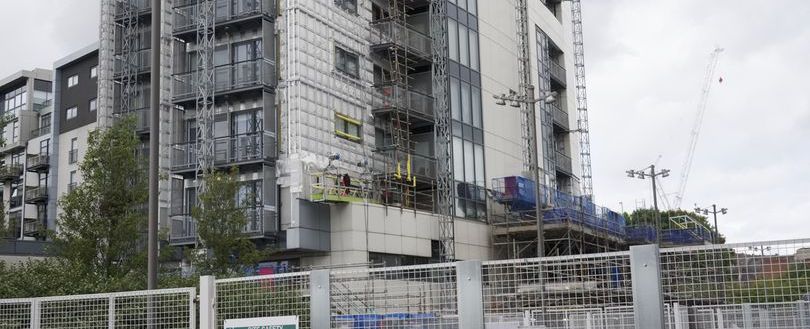
For all new high-rise housing over 18 metres, Gove mandates two staircases
Like it? Share it!
25 July 2023
Just before Christmas, the government released a consultation that included a suggestion to increase fire safety for residents of high-rise buildings by requiring two staircases in all new residential structures higher than 30 metres. Although the results of this consultation have not yet been made public, Gove stated in a speech delivered yesterday (July 24) that the government has decided to choose the lower 18m threshold after receiving "confirmation from expert bodies that they support this threshold."
When combined with our other fire safety measures and reforms, he said, "This is a considered and gradual evolution of safety standards" that "ensures the safety of people in all tall buildings, both new and existing."
With the new height limit, England will be on par with many other nations around the globe and Scotland, where single-stair towers over 18 metres are already prohibited. The National Fire Chiefs Council and a number of industry organisations had called for a lower trigger point.
Developers have complained about the consultation process and the uncertainty surrounding the height threshold's final setting, and many architects have already been forced to redesign their buildings.
Bell Phillips' 1,120-home project near Edgware Road is one of the recent changes, and the housing association Peabody has halted many of its large projects.
London projects have been particularly impacted by Mayor Sadiq Khan's February decision that all new buildings above 30 metres must include a second means of escape.
According to recent figures by industry tracker Glenigan, over 23,000 new residential units currently approved or in planning are likely to have caught up with the rule change.
At the UK Real Estate Investment & Infrastructure Forum in London in May, deputy mayor Jules Pipe claimed that as the sector awaited government clarification on second staircase rules, development in the city had 'ground to a halt'.At the UK Real Estate Investment & Infrastructure Forum in London in May, deputy mayor Jules Pipe claimed that as the sector awaited government clarification on second staircase rules, development in the city had 'ground to a halt'. Gove claimed that the threshold announcement "responds to the sector's call for coherence and certainty. "
The government is very clear that the new regulation cannot jeopardise the supply of homes by disrupting schemes that have been planned for years," the speaker continued. "DLUHC [the Department for Levelling Up, Housing, and Communities] will work quickly with industry and regulators over the summer to design transitional arrangements," he continued, "with the goal of securing the viability of projects that are already underway and avoiding delays where there are other more appropriate options."
"DLUHC [the Department for Levelling Up, Housing, and Communities] will work quickly with industry and regulators over the summer to design transitional arrangements," he continued, "with the goal of securing the viability of projects that are already underway and avoiding delays where there are other more appropriate options." mitigations.’
"DLUHC will work quickly on interim measures for projects already underway." The DLUHC expressed its concern that "some tall residential buildings are being designed with a single staircase without due consideration by the designers on the level of safety provided" in a document released on December 23. The department, which proposed the 30 m cutoff, stated: "It is our view that the provisions of a second staircase can provide some benefits for very tall residential buildings, such as added resilience for extreme events and reduced conflicts between emergency responders entering a building and those trying to escape, reducing the risk of the smoke ingress into an 'escape' stairwell."
‘In addition, [with] the provision of a second staircase, residents will have an alternative means of escape in the event one route becomes filled with smoke.’ In recent months, a group of organisations called on Gove to lower the threshold to 18 metres.
These included the RIBA, the Royal Institution of Chartered Surveyors (RICS), the Chartered Institute of Building (CIOB), the National Fire Chiefs Council (NFCC), Housing Learning and Improvement Network (Housing LIN), Disability Rights UK, Inclusion London and Claddag (Leaseholder Disability Action Group). ‘It is hugely positive and reassuring to see the government listening’ Responding to the news, RIBA president Simon Allford said: ‘This is a significant moment.
Over six years after the Grenfell Tower tragedy, it is hugely positive and reassuring to see the government listening to the united call of experts on fire safety, bringing greater coherence and certainty to the industry. ‘Mandating second staircases in new homes over 18m is a vital step towards a safer built environment for all. We are pleased to have played our part in this.’
Our eNews provides regular insight into industry trends, news headlines, and product and service information. For news articles parallel to those mentioned above, sign up for our eNews. Click here to sign up: Subscribe to our enews (fia.uk.com)
Related training
Related news
-
Business Owner Fined for Breaching Fire Safety Legislation
06 October 2025
Related resources
-
Fire Risk Assessors Standard Scope of Services
07 August 2025
-
Passenger Service Vehicle - Guidance Note
05 September 2023
